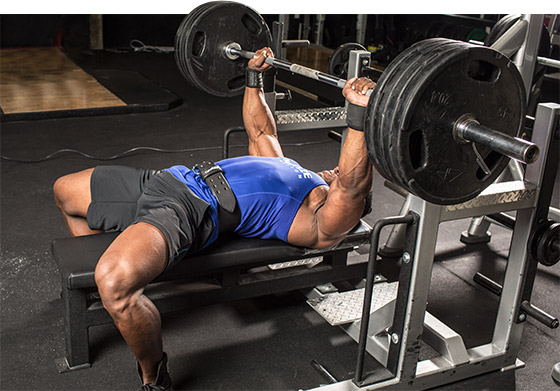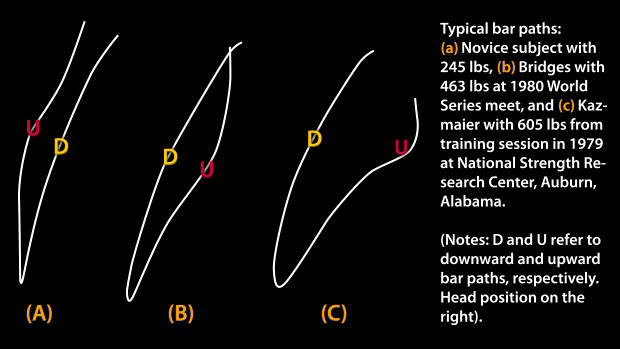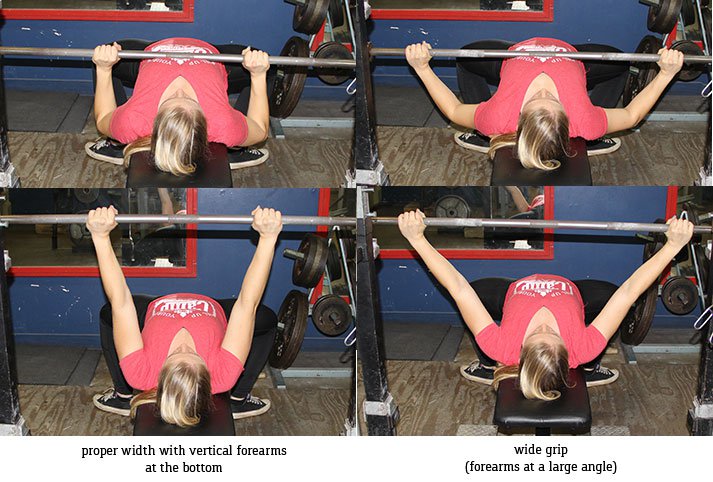Bench
Press

The bench
press is easily the most commonly known
exercise and an iconic definition
of strength for most people. Despite its
popularity, it happens to be the lift in which
the least amount of weight tends to be moved.
This is due to the primary used muscles being
weaker and the movement not being as natural.
Let's break this lift down as well:
Form
and Bar Path:
Form
is equally as important in the bench
press, but not for the same reasons as the
squat. Injury is much less likely due to
poor form, however, the amount of weight
that can be moved is significantly higher
when the lifter's form is correct. The
bench press proves to be a very technical
move that goes against some of the guide
lines in the squat and even a little
against physics. Unlike the
squat, an arched back is actually
recommended in the bench press. Since
there is no vertical load on the spine
during the movement, no shear force is
experienced by the disks in the spine and
no harm is done. The reason for the arch
in the spine is to raise the height of the
chest in
order to make the movement shorter. Since
the bar has to come in contact with the
chest and the movement ends with lo cked
out elbows, shortening the distance to the
lockout will reduce the work done
considerably. Another major difference in
the benching technique is that a nonlinear
bar path actually happens to be the most
efficient. A bar path going
straight down would cause
the elbows to flare which would unevenly
distribute the work done to the pectoral
muscles
from the triceps. The shown
diagram provides the most efficient bar
path that has been proven by professional
experience shown as path (C). Due to the
different leverages and moments
about joints in a nonlinear bar path, it
proves to be more practical than one that
is linear.
cked
out elbows, shortening the distance to the
lockout will reduce the work done
considerably. Another major difference in
the benching technique is that a nonlinear
bar path actually happens to be the most
efficient. A bar path going
straight down would cause
the elbows to flare which would unevenly
distribute the work done to the pectoral
muscles
from the triceps. The shown
diagram provides the most efficient bar
path that has been proven by professional
experience shown as path (C). Due to the
different leverages and moments
about joints in a nonlinear bar path, it
proves to be more practical than one that
is linear.
Variations:
Variations
to the bench press are much smaller in
number but also depend on personal
strengths and weakness es.
The variations
only vary from a wider grip on the bar
to a narrower grip. A wider grip will
shorten the range of motion to a small
extent but demands much greater
pectoral recruitment. Some have
proportionally stronger triceps,
therefore rather than decreasing the
ROM (range of motion), they benefit
more from a narrower grip that spreads
more of the load to the triceps. In
the end, the result is more dependent
of how the person is built rather than
looking at the lift from a physics
perspective.
es.
The variations
only vary from a wider grip on the bar
to a narrower grip. A wider grip will
shorten the range of motion to a small
extent but demands much greater
pectoral recruitment. Some have
proportionally stronger triceps,
therefore rather than decreasing the
ROM (range of motion), they benefit
more from a narrower grip that spreads
more of the load to the triceps. In
the end, the result is more dependent
of how the person is built rather than
looking at the lift from a physics
perspective.
For a very thorough article on the
bench press please click Here.